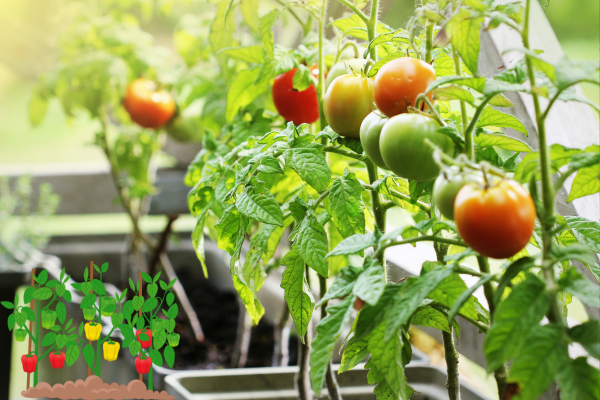Beginner’s Guide to Starting a Home Vegetable Garden – By Bhanuka – eLanka

Creating a home vegetable garden is a rewarding way to enjoy fresh produce and connect with nature. Whether you have a spacious backyard or a small balcony, you can grow your own vegetables with some planning and effort. Here’s a step-by-step guide to help you get started.
Step 1: Planning Your Garden
- Choose the Right Location:
- Sunlight: Most vegetables need at least 6-8 hours of direct sunlight daily. Choose a spot that receives ample sunlight.
- Soil: Ensure the soil is well-drained and fertile. Avoid areas where water pools after rain.
- Access: Make sure you can easily reach your garden for watering, weeding, and harvesting.
- Decide on the Garden Type:
- In-Ground Garden: Ideal if you have a spacious yard.
- Raised Beds: Good for areas with poor soil. They offer better control over soil quality and drainage.
- Containers: Perfect for small spaces like patios or balconies. Use pots, buckets, or any containers with drainage holes.
- Select Your Vegetables:
- Climate and Season: Choose vegetables that grow well in your local climate and season. Cool-season crops (e.g., lettuce, spinach) and warm-season crops (e.g., tomatoes, peppers) have different planting times.
- Space Requirements: Consider the space each plant needs. Vining plants like cucumbers need more room than compact plants like radishes.
Step 2: Preparing the Soil
- Test the Soil: Use a soil test kit to check pH and nutrient levels. Most vegetables prefer slightly acidic to neutral soil (pH 6.0-7.0).
- Improve Soil Quality:
- Organic Matter: Add compost, aged manure, or leaf mold to improve soil texture and fertility.
- Aeration: Loosen the soil with a garden fork or tiller to enhance root penetration and drainage.
Step 3: Planting
- Start Seeds or Buy Seedlings:
- Seeds: Starting from seeds is cost-effective and offers a wider variety. Start seeds indoors 6-8 weeks before the last frost date or directly sow them outdoors after the risk of frost.
- Seedlings: Buying young plants from a nursery is convenient and ensures quicker harvests.
- Planting Techniques:
- Spacing: Follow the recommended spacing on seed packets or plant tags to avoid overcrowding.
- Depth: Plant seeds at the correct depth. Generally, plant seeds at a depth of about twice their diameter.
- Watering:
- Initial Watering: Water immediately after planting.
- Regular Watering: Keep the soil consistently moist but not waterlogged. Early morning watering is best to minimize evaporation.
Step 4: Garden Maintenance
- Weeding: Regularly remove weeds to prevent competition for nutrients and water.
- Mulching: Apply a layer of mulch (straw, wood chips, or grass clippings) to retain soil moisture, suppress weeds, and regulate soil temperature.
- Fertilizing:
- Organic Options: Use compost, fish emulsion, or organic fertilizers.
- Timing: Fertilize according to the needs of your plants, typically every 4-6 weeks.
- Pest Control:
- Natural Methods: Encourage beneficial insects like ladybugs and use companion planting to deter pests.
- Physical Barriers: Use row covers, netting, or collars to protect plants from pests.
- Organic Sprays: Neem oil or insecticidal soap can help manage pest issues.
Step 5: Harvesting
- Know When to Harvest: Harvest vegetables at their peak ripeness for the best flavor and nutritional value. Refer to seed packets or plant tags for guidance.
- Harvest Regularly: Frequent harvesting encourages more production and prevents overripe vegetables from attracting pests.
- Post-Harvest Care:
- Clean Produce: Rinse vegetables under cool water to remove dirt and debris.
- Storage: Store vegetables properly to extend their shelf life. Leafy greens, for example, do well in the fridge, while root vegetables can be kept in a cool, dark place.
Additional Tips
- Start Small: Begin with a manageable garden size to avoid feeling overwhelmed.
- Keep a Garden Journal: Track planting dates, growth progress, and any issues encountered to learn and improve each season.
- Learn and Adapt: Gardening is a continuous learning process. Don’t be discouraged by setbacks; each season brings new opportunities to grow and improve.
By following these steps, you’ll be on your way to creating a successful home vegetable garden that provides fresh, delicious produce and a satisfying gardening experience. Happy gardening!







